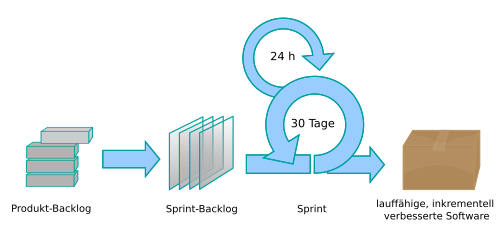
Image via Wikipedia
Since I started working at Embotics in 2007, we have always used an iteration length of 3 weeks. I don’t know why three weeks was chosen, though I suspect it provided a convenient trade-off between the amount of planning required to track the project and the amount of knowledge about where the project was going. As we increased our level of agility, we continued to use 3 weeks since it worked for us.
I’ve been talking with a number of others in our community and doing a lot of reading and it seems like we are an outlier here. Almost everyone else appears to be operating on 1 and 2 week iterations. The The Wisdom of Crowds indicates that we may be missing out on something here.
Now that we have completed our latest release, it is time to experiment with 2 week iterations. I expect that this will positively effect the way we work and will be watching for changes in some or all of the following:
- iteration planning will take less time but we will be doing it more often. This will force us to visit the story backlog more often and to make sure it is has the correct information in it for the upcoming iterations.
- there will be fewer stories in an iteration, which will lead to more pairing and collaboration to complete stories
- it will be easier to quickly highlight stories that are flow bottlenecks since there will be fewer stories in motion, thereby pointing to ways that we can improve flow
- there will be less slowdown at the end of iterations and less static friction at the beginning of iterations because we will be doing it more often on smaller sets of stories
- there will be a reduction in the hump in the burndown chart that occurs by the start of the second week. I am hoping that as we do more of these iterations, our system will start looking more like a kanban board.
- related to the reduction in the burndown chart hump, our focus level will be more consistent within the iteration. It has always been highest in the first week as we being new stories and at the end as we attempt to complete items in progress. If we eliminate that middle week, we may eliminate that temporary lull.
- we will be able to address new stories from customers quicker, since we tend to not interrupt an iteration once it has started
There are concerns on the team that we will need to watch out for:
- we will need to be more active in grooming the backlog since there is less time between iteration kickoffs. This may cause problems in periods when our product owner is busy with another hat or is on vacation
- we will be working towards 50% more iteration deadlines so things will be or seem to be busier. This may have impacts of fatigue levels, so we will have to ensure that we have a sustainable pace and allow time for recovery
- we haven’t defined hard success or failure metrics for this experiment. Velocity and burndown charts will be helpful here but I think we will rely on the heavily team’s feedback in retrospectives.